Vectors Meet Virtualization
Alex Bennée
FOSDEM 2018
Introduction
- Alex Bennée
- alex.bennee@linaro.org
- stsquad on #qemu
- Virtualization Developer @ Linaro
- Projects:
- QEMU, KVM, ARM
What is QEMU?
From: www.qemu.org
"QEMU is a generic and open source machine emulator and virtualizer."
Two Types of Virtualization
- Hardware Assisted Virtualization (KVM*)
- Cross Architecture Emulation (TCG)
Hardware Assisted Virtualization
High Performance, Cloud, Server Consolidation
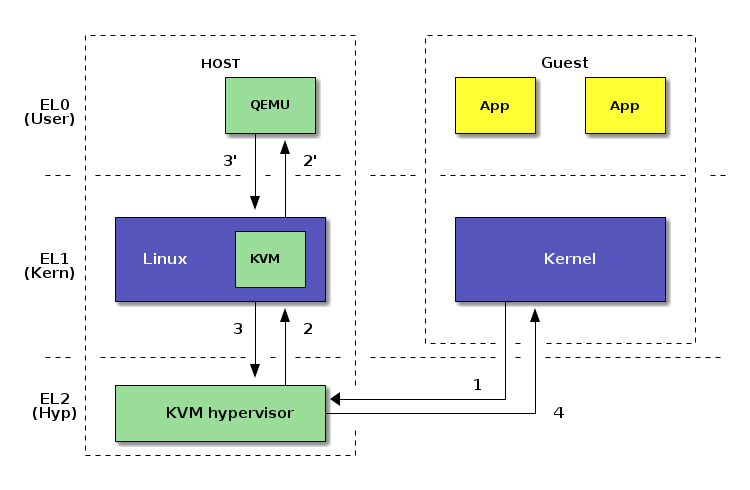
Full System Emulation
Android Emulator, Embedded Development, New Architectures
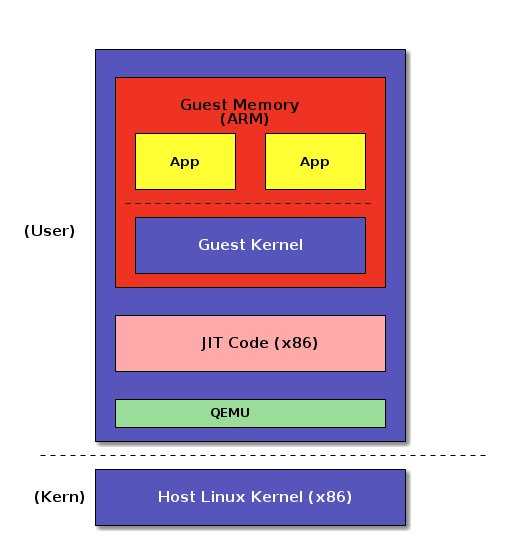
Linux User Emulation
Cross-development tools, Legacy binaries
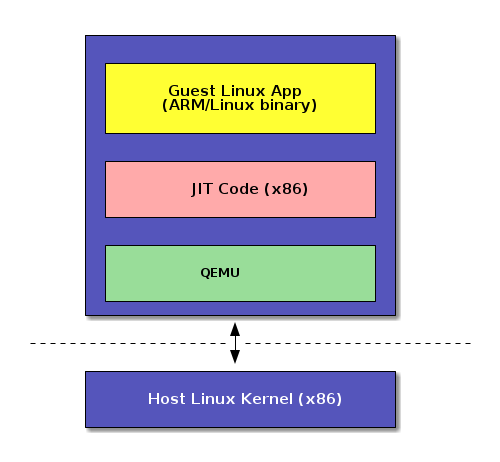
What are Vectors?
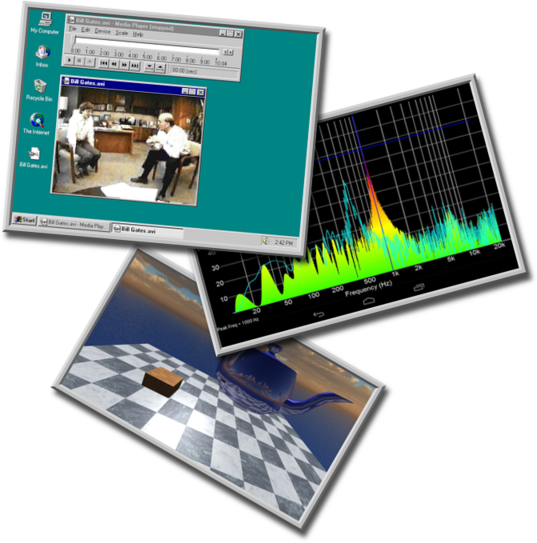
History Quiz
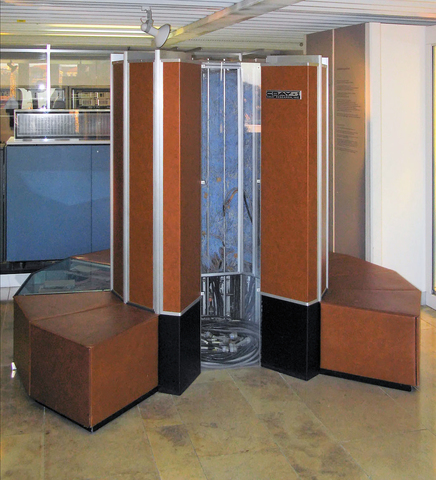
Cray 1 Specs
| Addressing | 8 24 bit address |
| Scalar Registers | 8 64 bit data |
| Vector Registers | 8 (64x64bit elements) |
| Clock Speed | 80 Mhz |
| Performance | up to 250 MFLOPS* |
| Power | 250 kW |
ref: The Cray-1 Computer System, Richard M Russell, Cray Reasearch Inc, ACM Jan 1978, Vol 21, Number 1
Architectures with Vectors
| Year | ISA |
|---|---|
| 1994 | SPARC VIS |
| 1997 | Intel x86 MMX |
| 1996 | MIPS MDMX |
| 1998 | AMD x86 3DNow! |
| 2002 | PowerPC Altivec |
| 2009 | ARM NEON/AdvSIMD |
Vector Register
128 bit wide, 4 x 32 bit elements

Vector Operation
vadd %Vd, %Vn, %Vm
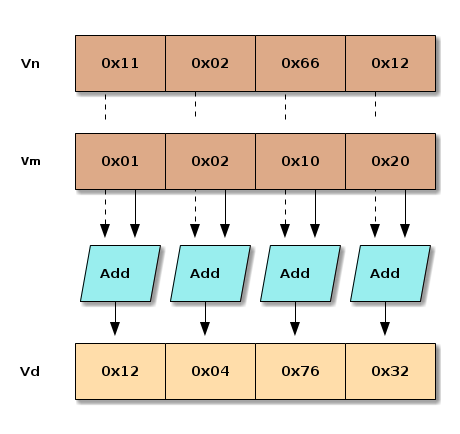
Vector Size is Growing
| Year | SIMD ISA | Vector Width | Addressing |
|---|---|---|---|
| 1997 | MMX | 64 bit | 2x32/4x16/8x8 |
| 2001 | SSE2 | 128 bit | 2x64/4x32/8x16/16x8 |
| 2011 | AVX | 256 bit | 4x64/8x32 |
| 2017 | AVX-512 | 512 bit | 8x64/16x32/32x16/64x8 |
ARM Scalable Vector Extensions (SVE)
- IMPDEF vector size (128-2048* bit)
- nx64/2nx32/4nx16/8nx8
- New instructions for size agnostic code
strcpy (C code)
void strcpy(char *restrict dst, const char *src) { while (1) { *dst = *src; if (*src == '\0') break; src++; dst++; } }
strcpy (SVE assembly)
sve_strcpy: # header mov x2, 0 ptrue p2.b loop: # loop body setffr # set first fault register ldff1b z0.b, p2/z, [x1, x2] rdffr p0.b, p2/z # read ffr into p0 cmpeq p1.b, p0/z, z0.b, 0 brka p0.b, p0/z, p1.b # break after st1b z0.b, p0, [x0, x2] incp x2, p0.b b.none loop ret # function exit
Predicate Registers
vadd %Vd, %Vn, %Vm, %Pp
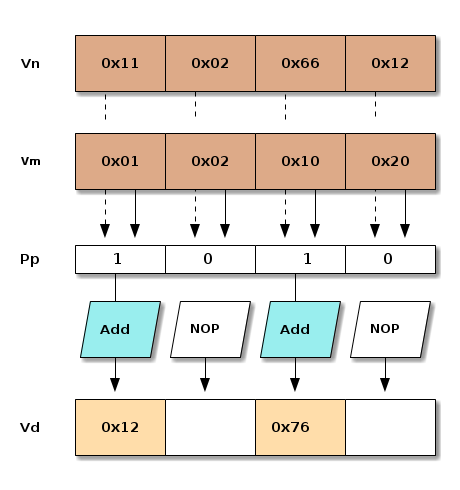
strcpy (SVE assembly setup)
sve_strcpy: ; setup index and set p2 all true mov x2, 0 ptrue p2.b
loop: ; clear first fault register, load into z0 setffr ldff1b z0.b, p2/z, [x1, x2] ; did we truncate due to fault? rdffr p0.b, p2/z
First Fault Register

strcpy (SVE assembly rest)
sve_strcpy: ; setup index and set p2 all true mov x2, 0 ptrue p2.b loop: ; clear first fault register, load into z0 setffr ldff1b z0.b, p2/z, [x1, x2] ; did we truncate due to fault? rdffr p0.b, p2/z
; any 0's in z0.b cmpeq p1.b, p0/z, z0.b, 0 brka p0.b, p0/z, p1.b
; store the string to destination st1b z0.b, p0, [x0, x2]
; how many bytes did we copy? incp x2, p0.b
; more? b.none loop ret
Recap
- Virtualization
- many flavours
- Vectors
- large registers
- growing usage
- data parallelism
Vectors meet (Tiny) Code Generation
- QEMU's TCG Mode
- Software only virtualisation
The X to Y problem
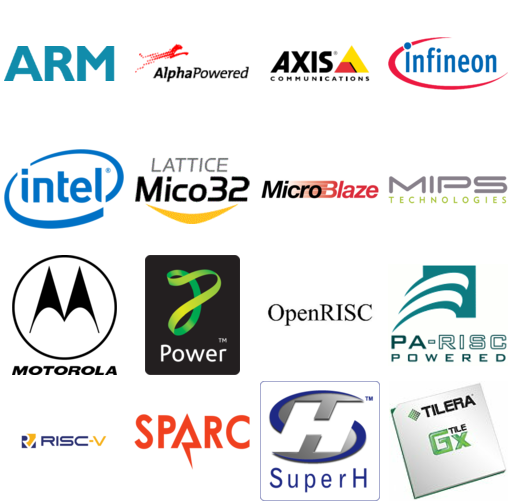
- 20 guest architectures
- 7 TCG Backends
Why Code Generation?
- interpreting slow
- common processor functionality
- logic
- arithmetic
- flow control
- compiler for machine-code
Code Generation
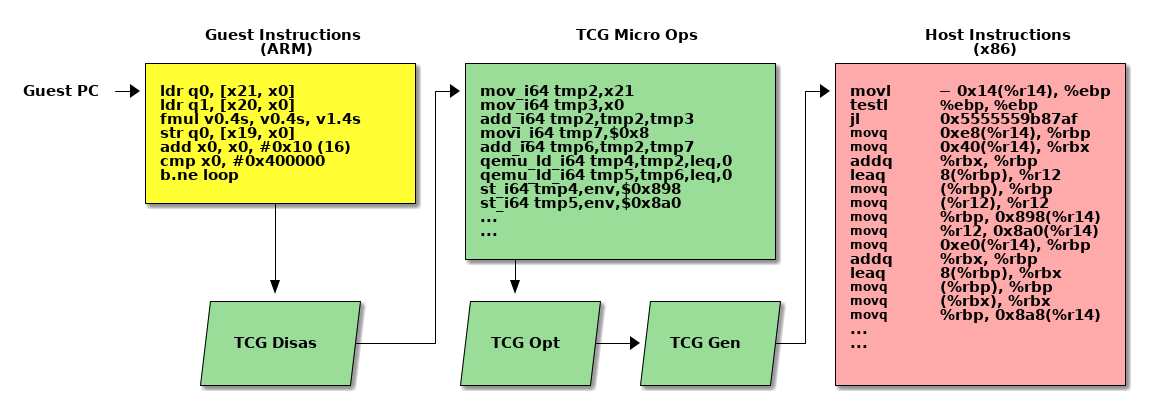
Float Multiply C Code
float *a, *b, *out; ... for (i = 0; i < SINGLE_OPS; i++) { out[i] = a[i] * b[i]; }
Float Multiply: Assembler breakdown
loop:
; load data from array ldr q0, [x0, x20] ldr q1, [x0, x19]
; actual calculation fmul v0.4s, v0.4s, v1.4s
; save result str q0, [x0, x1]
; loop condition add x0, x0, #0x10 (16) cmp x0, #0x400000 (4194304) b.ne loop
TCG IR: ldr q0, [x0, x21]
Load q0 (128 bit) with value from x21, indexed by x0
; calculate offset mov_i64 tmp2,x21 mov_i64 tmp3,x0 add_i64 tmp2,tmp2,tmp3
; offset for second load movi_i64 tmp7,$0x8 add_i64 tmp6,tmp2,tmp7
; load from memory to tmp qemu_ld_i64 tmp4,tmp2,leq,0 qemu_ld_i64 tmp5,tmp6,leq,0
; store in quad register file st_i64 tmp4,env,$0x898 st_i64 tmp5,env,$0x8a0
TCG IR: fmul v0.4s, v0.4s, v1.4s
; get adddress of fpst movi_i64 tmp3,$0xb00 add_i64 tmp2,env,tmp3
; first fmul.s ld_i32 tmp0,env,$0x898 ld_i32 tmp1,env,$0x8a8 ; call helper call vfp_muls,$0x0,$1,tmp8,tmp0,tmp1,tmp2 st_i32 tmp8,env,$0x898
; remaining 3 fmul.s ld_i32 tmp0,env,$0x89c ld_i32 tmp1,env,$0x8ac call vfp_muls,$0x0,$1,tmp8,tmp0,tmp1,tmp2 st_i32 tmp8,env,$0x89c ... ...
TCG Types
| Type | |
|---|---|
| TCGv_i32 | 32 bit integer type |
| TCGv_i64 | 64 bit integer type |
| TCGv_ptr* | Host pointer type (e.g. cpu->env) |
| TCGv* | target_ulong |
TCG Types and TGC Ops
- TCGOp has explicit sizes/params
tcg_gen_addi_i32(TCGv_i32 ret, TCGv_i32 arg1, int32_t arg2); tcg_gen_addi_i64(TCGv_i64 ret, TCGv_i64 arg1, int64_t arg2);
Types for Vectors?
- Type for each Vector Size?
- TCGv_i128, TCGv_i256…
- Type for each Vector Layout?
- TCGv_i64x2, TCGv_i32x4…
- Don't forget smaller size ops
- TCGv_i16x8, TCGv_i16x16…
- TCGv_i8x16, TCGv_i8x32…!
Problem
Each TCGType -> more TCGOps
TCG_vec Design Principles
- Support multiple vector sizes
- without exploding TCGOp space
- Helpers dominate floating point
- avoid marshalling, pass pointers
- Integer/Logic should still use host code
- TGCOp needs enough info for backend
TCG_vec Code Generation
Guest (ARM)
eor v0.16b, v0.16b, v1.16b
TCG Ops
ld_vec tmp8,env,$0x8a0,$0x1 ld_vec tmp9,env,$0x8b0,$0x1 xor_vec tmp10,tmp8,tmp9,$0x1 st_vec tmp10,env,$0x8a0,$0x1
Host (x86, SSE)
vmovdqu 0x8a0(%r14), %xmm0 vmovdqu 0x8b0(%r14), %xmm1 vpxor %xmm1, %xmm0, %xmm0 vmovdqu %xmm0, 0x8a0(%r14)
TCG_vec gives us
- better code generation
- more efficient helpers
Benchmarks (nsec/kop)
| Benchmark | Native | TCG | TCG_vec |
|---|---|---|---|
| bytewise-xor | 670 | 331 | 632 |
| bytewise-xor-stream | 235 | 330 | 450 |
| wordwide-xor | 1349 | 687 | 1260 |
| bytewise-bit-fiddle | 396 | 716 | 521 |
| float32-mul | 2717 | 8401 | 8665 |
Bytewise Bit Fiddle: C Code
uint8_t *and, *add, *sub, *xor, *out; ... for (i = 0; i < BYTE_OPS; i++) { uint8_t value = out[i]; value |= i & and[i]; value += add[i]; value ^= xor[i]; value -= sub[i]; out[i] = value; }
Bytewise Bit Fiddle: Assembly
; main loop mov x0, #0x0 mov v1.16b, v29.16b add v0.2d, v1.2d, v27.2d add v17.2d, v1.2d, v26.2d add v2.2d, v1.2d, v25.2d add v16.2d, v1.2d, v23.2d add v7.2d, v1.2d, v21.2d add v20.2d, v1.2d, v24.2d xtn v19.2s, v1.2d xtn2 v19.4s, v0.2d add v18.2d, v1.2d, v22.2d ... ... eor v0.16b, v0.16b, v3.16b sub v0.16b, v0.16b, v2.16b str q0, [x19, x0] add x0, x0, #0x10 (16) cmp x0, #0x400000 (4194304) b.ne #-0x8c (addr 0x4011a0)
Benchmarks (nsec/kop)
With -funroll-loops
| Benchmark | QEMU | QEMU TCG_vec |
|---|---|---|
| bytewise-xor | 332 | 338 |
| bytewise-xor-stream | 169 | 185 |
| wordwide-xor | 670 | 631 |
| bytewise-bit-fiddle | 661 | 469 |
| float32-mul | 7941 | 7634 |
Further Work
- ld/st handling
- better register liveliness
Vectors meet KVM*
- Xen
- HAXM (Windows)
- HVM (MacOS)
Architecture
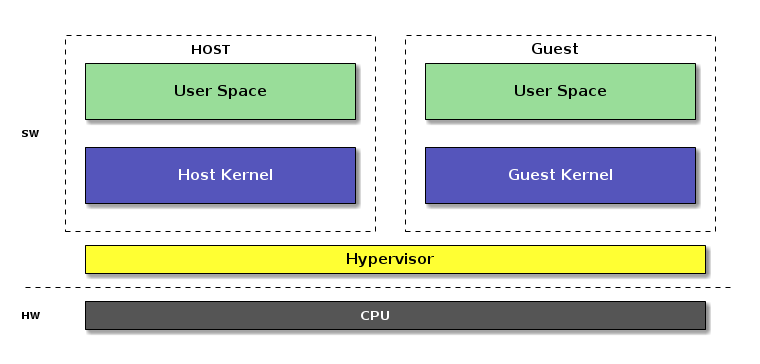
CPU Resources
- Shared execution environment
- Virtualized resources for guest
- Trap and Emulate
- Context Switch
Swapping Context in Host Kernel

Size of ARMv8 Contexts
- 32 x 64 bit integer regs (256 bytes)
- 32 x 2048 bit SVE regs (8192 bytes)
- 32 times bigger!
Who uses SIMD (and FP!)
- Userspace
- dedicated vectorized workloads
- accelerated library functions
- Kernel
- Crypto
- RAID
- Hypervisor
- Not really
Detecting Usage
- Disable SIMD/FPU access
- First usage with Trap
- swap context
- enable SIMD/FPU
- return to trapped insn
Deferred State Bookeeping
- per CPU variable
- fpsimd_last_state
- per Task Variables (task_struct)
- fpsimd_state
- TIF_FOREIGN_FPSTATE flag
VM is mostly the same

Enabling SVE on ARM
- Kernel support in 4.15
- Enabling SVE for KVM guest
- work in progress
Summary
- Vectors are great
- Vectors are large!
- Need special handling by
- Kernels
- Hypervisors
- Emulators
Questions?
Extra Slides
Benchmark Code
See: https://github.com/stsquad/testcases/blob/master/aarch64/vector-benchmark.c